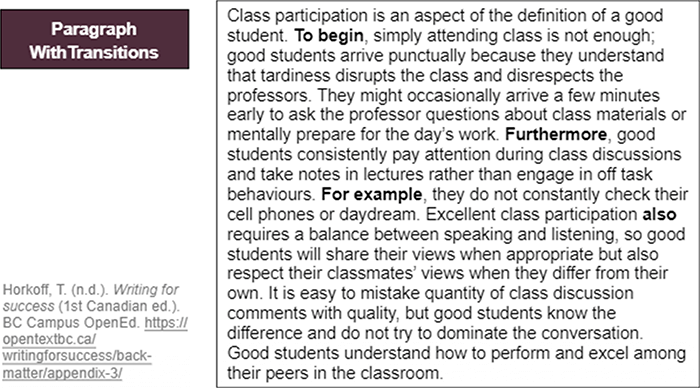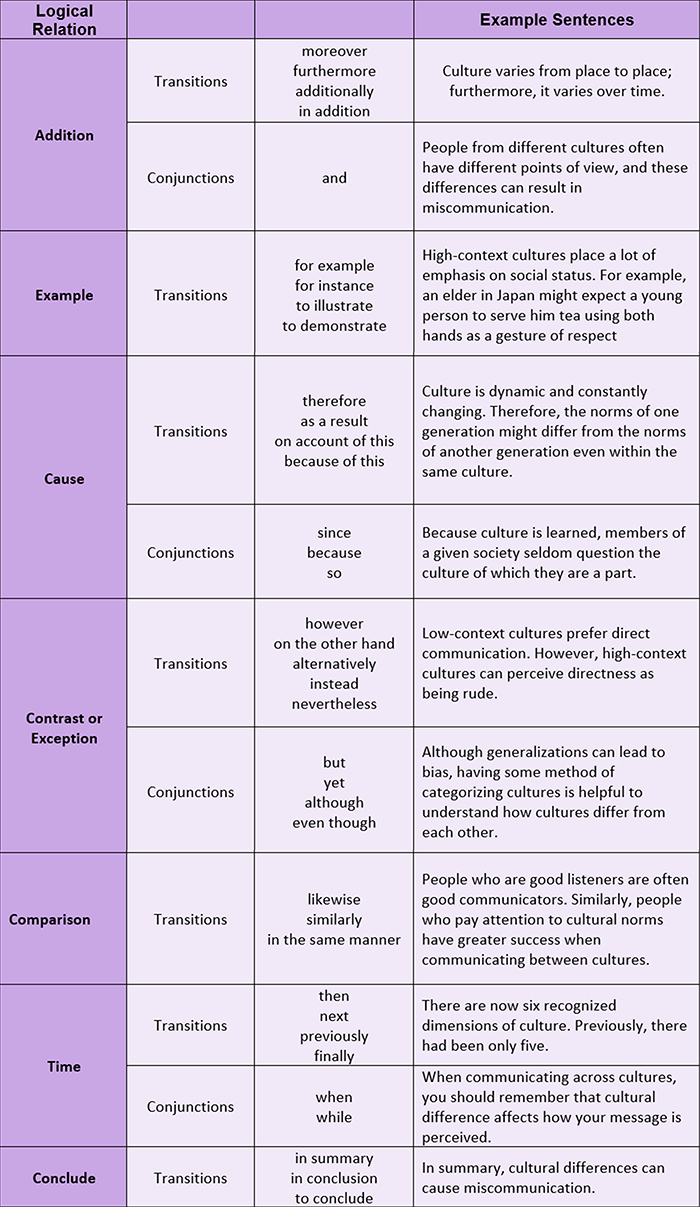32 Transitional Elements
Learning Objectives
After completing this chapter, you will be able to
- understand the importance of transitions
- identify the three different types of transitional elements
- know how to use punctuation with different transitional elements
- identify and define common transitional words and phrases
Importance of Transitional Words and Phrases
Transitional words and phrases enable your reader to understand how one idea relates to the previous idea. Transitions form logical connections between ideas, and they strengthen the organization of these ideas. Transitions signal the order of ideas, highlight relationships, unify concepts, and let readers know what’s coming next or remind them about what’s already been covered.
When instructors or peers comment that your writing is choppy, abrupt, or needs to “flow better”, those are some signals that you might need to work on building some better transitions into your writing.
Compare the sample paragraphs with and without transitions; notice how the paragraph with the transitions flows better.
Video Overview of the Three Types of Transitional Elements
Watch this video to learn how to correctly use conjunctive adverbs, coordinating conjunctions, and subordinating conjunctions.
Meaning and Use of Common Transitions
Effectively incorporating transitions often depends upon your ability to identify words or phrases that will indicate for the reader the kind of logical relationships or connections you want to convey.
View the chart below or check out this website to see how to use different transitions and conjunctions.
Grammar Tip
When your teachers talk about “transitional elements,” they are probably referring specifically to “conjunctive adverbs”: therefore, however, additionally, finally, etc. These types of transitional elements link ideas, but they do not join sentences.
Typically, these transitions can only be placed
1. At the beginning of a sentence:
I studied hard. Consequently, I passed the test.
2. After a semi-colon that joins two related sentences
I studied hard; consequently, I passed the test.
Remember that a comma is needed after the transitional element to offset it from the main sentence clause. For more information about commas and semi-colons, see the Punctuation chapter.
Transitions to Show Order of Importance
Transitions can be used to show order of importance, which means arranging your ideas from most to least important or vice versa. Sometimes you may want to end with the most important idea so that it acts as the climax at the end of the paragraph or essay.

Transitions to Show Additional Support
Transitions can be used to show additional support for an idea.

Transitions to Introduce Examples
The simplest way to tell a reader that an example will follow is to say so using a transitional word or phrase.

Transitions to Show Time Order
Transitions can be used to indicate chronological order, which means to arrange ideas in order from present to past or from past to present. Similarly, transitions can be used to show a sequence of events, which means to arrange ideas in the order that they happen.

Transitions to Show Similarity
Transitions can be used to compare ideas. In other words, transitions can connect ideas by suggesting that they are in some ways alike.

Transitions to Show Contrast
Transitions can be used to contrast ideas. In other words, transitions can connect ideas by suggesting that they are in some way different.

Transitions to Summarize or Conclude
Transitions are also used to introduce a summary or conclusion in a paragraph or essay.

Learning Check
Additional Resources
To learn more about transitional elements
- read about coherence in Chapter 8.4 of Writing for Success [1]
- review the list of transitions and their meanings at the UW-Madison Writing Centre
- try this interactive online activity on Connectives
- Writing for Success is adapted from a work produced and distributed under a Creative Commons license (CC BY-NC-SA) in 2011 by a publisher who has requested that they and the original author not receive attribution. This adapted edition is produced by the University of Minnesota Libraries Publishing through the eLearning Support Initiative. ↵




